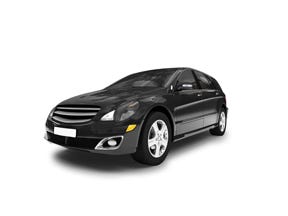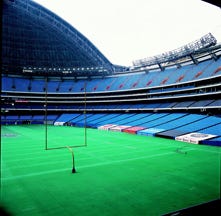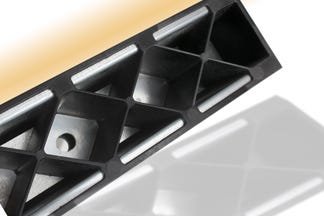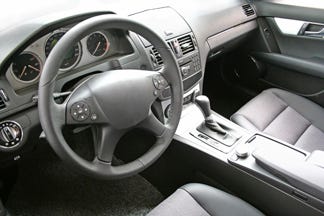Additives add buzz to NPE
Although often the unsung heroes in a plastics processor’s compound recipe, additives’ pace of development is as swift or swifter than in any other corner of the industry. The benefits of these, too, are as far-reaching as with any other development: Improved mechanical properties, weight savings, energy savings, and improved efficiency are just some of the benefits additives can bring to a processor’s game.
September 14, 2009
Although often the unsung heroes in a plastics processor’s compound recipe, additives’ pace of development is as swift or swifter than in any other corner of the industry. The benefits of these, too, are as far-reaching as with any other development: Improved mechanical properties, weight savings, energy savings, and improved efficiency are just some of the benefits additives can bring to a processor’s game.
Senior editor Robert Colvin chased down the latest and greatest in the additives world during the NPE trade show; here is his report.
FUNCTIONAL FILLERS
Processor takes 
advantage of glass 
bubble buoyancy
|
Highlighting the 3M display during the recent NPE were two innovative undersea applications produced by CMT Materials. Newly developed coatings help bring improved physical properties such as tensile strength, elongation, and stiffness to 3M Glass Bubbles, a microsphere functional filler. The coatings, such as bifunctional amino silane coupling agents, are either bonded to the surface of the bubble or chemically react with the surface to modify and functionalize the surface. Bubbles average 15-30 µm in size and have crush strength up to 30,000 psi (207 MPa).
CMT uses the 3M Glass Bubbles in a syntactic foam to produce a novel archival tag, called a digital acoustic recording tag (DTAG), developed by Woods Hole Oceanographic Institute in Massachusetts to monitor the behavior of whales and their response to sound while they dive. The tag contains an array of solid-state memory and records continuously from a built-in hydrophone and sensors. The DTAG is noninvasive and is attached to a whale’s body with four silicone suction cups using a 12m cantilevered carbon-fiber pole. The glass bubbles not only lighten the device but also provide buoyancy. The tags are programmed to release from the mammal by venting the suction cups upon ending the recording time. A VHF beacon in the tag aids in tracing and recovering the device.
In another application, CMT has been working with both Woods Hole Oceanographic and Hydroid Inc. to produce Remus AUVs (autonomous undersea vehicles). These submarines resemble a torpedo that navigates without a human crew onboard. Robots control them completely; there are no cables connecting them to research vessels at the sea surface. The vehicles are designed for coastal monitoring as well as survey operations at various depths in the ocean. Syntactic foam processed by CMT supplies the sub-sea buoyancy package, with that buoyancy thanks to the combination of 3M hollow glass bubbles in an epoxy matrix. A composite skin is incorporated to the package. The glass microspheres provide a high strength-to-weight ratio, which translates into more buoyancy per unit volume, increased payloads, deeper water operations, and increased range of operations.
3M, energy and advanced materials division, St. Paul, MN, USA; +1 800-367-8905; www.3M.com/microspheres; CMT Materials, Attleboro, MA, USA; +1 508-226-3901; 
www.cmtmaterials.com
It’s the size of the fight 
in the dog
Small, yes, but plenty powerful: Jetfine 3CC from Rio Tinto Minerals is a submicron, noncoated talc that provides reinforcement in plastics applications. It retains its lamella structure in applications to provide stiffness and improve impact strength. It also shows good cold ductile properties. The product is densified to reduce dusting problems and improve handling. In many applications it also improves both mar and scratch resistance.
Rio Tinto Minerals, Greenwood Village, CO, USA; +1 303-713-5503; www.riotintominerals.com
Agent strengthens goods without adding weight
|
Milliken introduced during NPE2009 a new reinforcing agent, Hyperform HPR803, designed to offer comparable performance but lower weight compared to competitive mineral fillers such as talc. Johnny Netzloff, global marketing manager–Hyperform at the company, told MPW during the show that processors using the material on a test basis so far have been able to replace up to 30% talc with only 5-10% of this material and achieve comparable or better results in their final parts. Weight reduction in polyolefin parts can be as much as 15%.
The filler also helps improve the surface features of glass-filled polypropylene (PP). It exhibits better modulus enhancement than some talc, creating ways to produce stiffer resins. Gardner impact strength is also improved with 10% HPR803 inclusion, matching comparable stiffness levels of 30%-talc-reinforced parts. HPR803 is also said to give a better physical property balance. Mar and scratch resistance is also up. Milliken targets HPR803 for a wide range of interior and exterior automotive parts.
Milliken Chemical, Spartanburg, SC, USA; 
+1 864-503-1167; www.millikenchemical.com
PROCESSING AIDS
Material ensures melt homogeneity
BYK has unveiled a processing additive, P4102, which improves dispersion of pigments and mineral fillers in thermoplastics compounds and masterbatches based on PE, PP, ABS, PA, or PVC. The additive improves pigment/filler dispersion, which leads to improved filter pressure values (FPV) and thus higher throughput during extrusion. It also is said to have a positive influence on the viscosity behavior of masterbatches or compounds. It reduces problems of agglomeration, poor filter pressure values, low color strength, black specks, and poor physical properties of the final product.
BYK USA, Wallingford, CT, USA; 
+1 203-265-2086; www.byk.com/additives
MASTERBATCHES
Improve performance with peroxide masterbatches
Polyvel has a line of free-flowing, pelletized peroxide masterbatches for crosslinking polyethylene (PE). This PCL series is claimed to be easier and safer to use than alkyl peroxide powders and liquids. It also eliminates “bridging” seen with powders, which translates into more accurate dosing and more reliable properties. Let down into PE during extrusion, injection molding, blowmolding, or rotational molding, the melt exhibits greater melt, tensile, flexural, and impact strength. Part thickness and weight can be decreased while existing properties are maintained. Longer shelf life is said to be another advantage of peroxide masterbatches, as they retain their properties longer than liquids and powders. The company offers several peroxide chemistries, at 1%-40% loading, in resins compatible with applications.
Polyvel Inc., Hammonton, NJ, USA; 
+1 609-567-0080; www.polyvel.com
Quick dissolving aid helps with colors
Solplus DP320 and DP330 from Lubrizol are hyper-dispersants that help obtain a uniform and homogenized color distribution of color masterbatches. The white powder includes 100% active content and helps ensure better color strength development. The company says that customers are asking especially for good dispersion of flesh colors for containers and for other packaging. These two grades are designed, with the help of proprietary technology, to provide a less labor-intensive product that is also globally available. They can also be used to help realize good filler distribution in both thermoplastic masterbatch and compounds.
Lubrizol Advanced Materials, Cleveland, OH, USA; +1 216-447-5000; www.solsperse.com
COLORANTS
White gets extra help from icy frosting
Glacier Frost White EH682 is claimed by its supplier, BASF, to be the whitest effect pigment on the market today. Unlike existing products, this synthetic mica coated with titanium dioxide offers high luster, brightness, and yields a “whiter” white in many plastics applications. Its pearlescent effect has a bluish reflection color to create white to black shades without a yellowing effect. Since it is a synthetic mica (fluorophlogopite), it is transparent and does not include natural impurities such as iron oxides that are found in mined mica. The material has FDA food contact approval.
BASF, Coatings & Plastics Chemicals, Ludwigshafen, Germany; +49 621-60-71910; www.basf.com/pigment
Colorants take on new hues for WPC
Wood-plastic compounds (WPC) take on a new luster with the help of Smartbatch OnColor WPC colorants and additives packages from PolyOne. The portfolio of materials has been formulated for compatibility with many different natural fibers to include with postconsumer recycled natural fibers. These “cooler-to-the touch” low-heat-absorption colorants in highly loaded, small-bead geometry resist fading and provide improved color distribution over previous materials. They can be used for either molding or extrusion applications. The line of products also is offered with Streaker technology that mimics the aesthetic appearance of tropical hardwoods. OnColor WPC colorants and additives are both warp and UV stable, resist mold and mildew, offer mar or scratch resistance, and are hydrophobic.
PolyOne, Avon Lake, OH, USA; 
+1 440-930-1000; www.polyone.com
Ultramarine grade wins 
at Olympics
|
Ultramarine blue 6117 Premier XAR grade from Holliday Pigments proved a winner at the Beijing Olympic games in 2008. The colorant was selected for stadium seats after competitive products failed to make the grade in a series of acid resistance and weathering tests to find a performance pigment suitable for the seating at the Beijing stadium. To prevent high energy radiation from the sun from bleaching the seating, it was essential by game organizers to find an acid-resistant blue that was strong enough to withstand a long service life and environmental problems such as acid rain.
This material is rendered acid resistant by means of an inert coating deposited on the surface of the pigment particle. Other coated grades showed problems during dispersion in the melt and abrasion to the coating that reduced acid resistance. Premier XAR coating technology both delivered 50% improved acid resistance and cut the effects of abrasion in half, says Martin Elliott, regional sales/marketing manager at the company.
Holliday Pigments, Comines, France; 
+33 3-206-31200; www.holliday-pigments.com
Pearly luster adds value to applications
A range of glass pearl pigments under the brand Luxan from Eckart is based on artificial glass substrates and shows high transparency due to smooth and optically correct surfaces. These TiO2 coated pigments provide better brightness and reflecting power than competitive materials, says the company. This reflecting power leads to distinct flashy and clear color styling for applications in cosmetics and personal care products, automotive, and leisure applications.
Also new from the company and shown during NPE2009 were the Silvershine aluminum pigments. These provide good brilliance and hiding power. Mark Stoll, global business line manager plastics at the supplier, told MPW during the show that Silvershine pigments enable processors to achieve silver quality in mass tinting that could so far be achieved only via surface coating. According to him, the material has about 30% higher opacity compared to conventional Silver Dollar-type pigments with similar particle size distribution. It contains 80% aluminum pigment in a carrier of purified medical white oil, a di-isononyl-phtalate solvent, or a universally compatible carrier.
Eckart America, Louisville, KY, USA; 
+1 502-775-4241; www.eckart.net
PROPERTY MODIFIERS
Ionic monomers augment mechanical properties
An ionic monomer (SR732) from Sartomer can be used as a crosslinking agent for polyolefin modification. This crosslinking agent increases the tensile modulus somewhat and improves stiffness, which was seen as a significant gain in modulus at heat deflection temperature (HDT) of low-density polyethylene. Significant gains in HDT are possible with as little as 5% loadings. The company also has introduced a styrene maleic anhydride copolymer, SMA2021, used to improve water and heat resistance in polymer modification. It is available in flake, powder, and ammonia solution form.
Sartomer, Exton, PA, USA; +1 610-363-4100; www.sartomer.com
Adhesion promoter aids hybrid components
|
A copolyamide adhesion promoter based on nylon 12 from Evonik is said to absorb a greater amount of force in hybrid component panels for automotive applications, which means lighter panels can deliver the same level of performance as heavier ones not using the material. This additive improves bonding of steel and aluminum to fiberglass-reinforced nylons. It can also be used in steel and polyphthalamide (PPA) hybrid components. Since it is a granular material, it can be directly applied after the melt process. This means no film has to be made beforehand, which would require additional energy input. In powder form it can be applied using an electrostatic coating process.
Evonik Degussa, Parsippany, NJ, USA; 
+1 810-225-8635; www.evonik.com
Easy-to-use package makes processing speedy
VM512 from Struktol is a blend of mineral additives in a yellow to white pellet polymer carrier. It functions as a matting agent for rigid PVC to produce a matted or textured surface. It is intended for water channeling applications or where a matted textured surface on extruded or calendered rigid vinyl products is desirable. Dosage ranges from 0.5%-3.0%/wt of the total compound. The material is sanctioned for use by the FDA in a number of applications.
Struktol Co. of America, Stow, OH, USA; 
+1 330-928-5188; www.struktol.com
Scratches, mar are passé with this new additive
|
Axel Plastics Research Laboratories has come out with a new additive designed to improve the scratch and mar resistance of thermoplastic polyolefin (TPO) used in automotive applications. MoldWiz INT701S, in powder or pellet form, resists scratching at 15N force. It resists scratch whitening at up to 15.4N when tested by ASTM D7027-05 test method and 13N in Ford five-finger testing. Company spokesperson Nancy Teufel told MPW during NPE that the new product appears to be suited to TPO resin formulations that have lower loadings of rubber and talc as well as to polyolefins that contain neither rubber nor filler. In evaluation for compatibility with UV stabilizers, tests yielded reflectance values that meet automotive standards with no visual indication of film or droplet formation as is common with some additives that employ primary amides such as erucamide or oleomide.
Axel Plastics Research Laboratories, Woodside, NY; +1 718-672-8300; 
www.axelplastics.com
LUBRICANTS/SLIP AGENTS
New series gives PVC that extra slip
Like never before, processors are being asked to produce parts faster and with improved performance qualities at lower cost. Stuktol’s VLB series of lubricant ester-based products are functional packages derived either from vegetable oil or tallow. Grade 602 is intended for transparent calendered vinyl applications such as sheets for product packaging, while grade 701 can be used for either extruded or calendered PVC where good metal release is key. Grade 901 targets blister packaging and credit or gift card stock. Michael Fulmer, product manager plastics additives at Struktol, told MPW that the company is developing more one-pack solutions for processors since some large suppliers in the market are cutting back in this area.
Struktol Co. of America, Stow, OH, USA; 
+1 330-928-5188; www.struktol.com
COMPOUNDS
Metallic-look vinyl helps eliminate need to paint
|
A portfolio of metal-effect rigid vinyl molding compounds from PolyOne, marketed under the Geon brand, is intended to eliminate secondary processes such as painting or plating of PVC parts for home appliances. The material permits designers to substitute a precolored PVC compound for metal or painted/lacquered plastics parts. It helps reduce the return by consumers of goods due to surface scratches and mars, because the color goes though the part and is not simply applied to the surface. By obviating the need for painting or plating, these compounds also help customers to avoid generating volatile organic compounds (VOCs) on the shop floor. These compounds also allow a designer to mask weldlines by moving them to areas not readily viewed by users.
PolyOne, Avon Lake, OH, USA; 
+1 440-930-1000; www.polyone.com
Compostable bags gain greening help
During NPE2009, Heritage Plastics premiered its BioTuf976 for compostable bag production. This pelletized mineral-content compound is based on a blend of biodegradable resins including an aliphatic/aromatic copolyester. It is designed to be extruded and converted on standard low-density-polyethylene (LDPE) or grooved-feed high-molecular-weight HDPE processing equipment. Such films are said to have similar properties to LLDPE web. “Films up to 3.0 mil (76 µm) thick will completely degrade in commercial and municipal composting environments in accordance with ASTM D6400 specifications,” says Holly Hansen, VP technical services at the company. The material can also be used in the processing of sheet for thermoforming and for injection molding.
Heritage Plastics, Picayune, MS, USA; 
+1 601-798-8663; www.heritage-plastics.com
BLOWING AGENTS
Free-flow materials aid 
in processing
Reedy International introduced an endothermic, free-flowing powder, Saftec XP600, to foam plastics applications. It is a low-temperature powder designed to create foam structures in applications including building and construction, automotive, footwear, wire and cable, profiles, furniture, and household items. It is recommended for olefinic- and vinyl-based thermoplastics but can be used in any resin that reaches the decomposition temperature during processing and is not moisture sensitive. The material improves processing cycles, reduces energy use, and lowers overall costs, says the company.
Reedy International, Keyport, NJ, USA; 
+1 732-264-1777; www.reedyintl.com
OTHER ADDITIVES
Material helps kill 
unwanted car odors
BYK-P4200 reduces odor and emission in molded polypropylene parts. This aqueous solution of polymeric, surface active substances is absorbed onto a PP carrier and is said to be easy to use. It has no negative influence on the mechanical and optical properties of the end product. The additive functions not as an odor masker but as a scrubber.
BYK USA, Wallingford, CT, USA; 
+1 203-265-2086; www.byk.com
Metal equipment 
shipments get help 
from packaging
Shipping large equipment that is wrapped in stretch or shrink film over long distances, including overseas, can result in problems of corrosion before the machinery arrives at its end destination. To the rescue comes the Chemstat CI Series from PCC Chemax, a vapor phase corrosion inhibitor for polyolefin blown film pallet wrap. The migratory inhibitors provide corrosion protection against salt air and heavy-humidity atmospheres. It is designed for use in high-melt-flow polyolefins. Grades CI1000 and CI1020 are fast-blooming volatile corrosion inhibitor (VCI) additives in liquid form. The additive helps prevent corrosion on steel, iron, copper, and aluminum alloys.
PCC Chemax, Piedmont, SC, USA; 
+1 864-422-6644; www.pcc-chemax.com
The additives coverage doesn’t stop here. Look up this article at plastics
today.com/mpw for more from NPE, including plasticizers, stabilizers, purging compounds, and flame retardants.
About the Author(s)
You May Also Like







